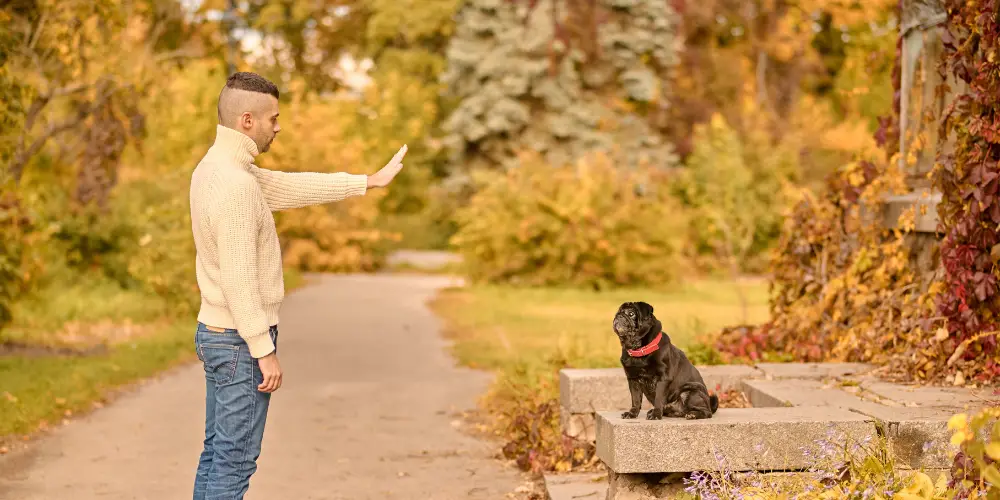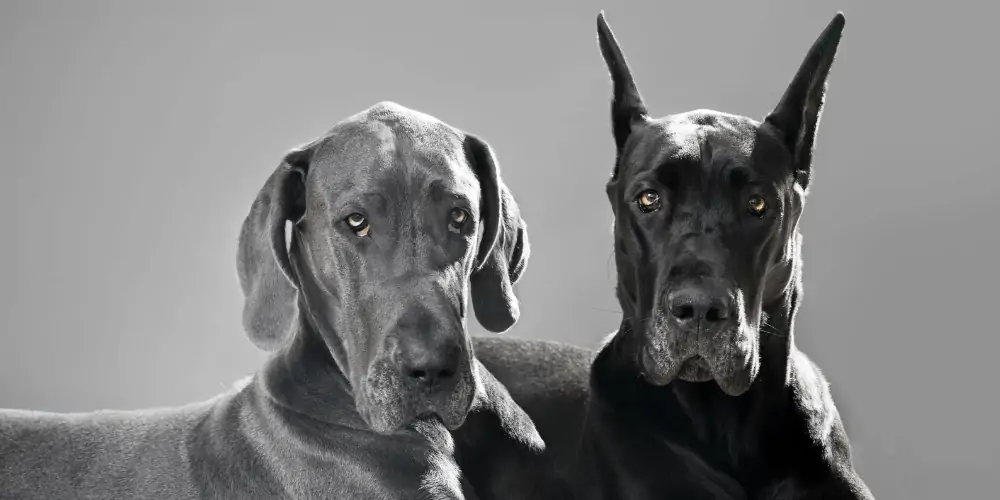Every person who feels ready to own a dog for the first time has their fair share of hurdles to cross, the largest of which is successfully training their new dog.
These are the 10 essential dog commands for every dog owner, along with some helpful tips and pointers to make this process a little less daunting for the new owner.
The 10 Essential Dog Commands
- Sit
- Stay
- Come
- No
- Drop
- Heel
- Down
- Off
- Quiet
- Go
Why are they essential and most common? Because they’re the most effective, touching on most things that will be presented to a dog and their owners daily.
The better a dog grasps these basic commands, the easier and more enjoyable the experience is for the owners and the dog. One dog command can be used to handle multiple situations.
Let’s dig deeper with explanations, and examples, teaching the dog to obey them while also teaching the owner how to reinforce them positively.
1. Sit or Sit Down ( Time to Pay Attention )

Teaching your puppy to sit might be a challenge at first, but in time will become a hinge on which many other commands will spawn from. We’ll discuss that later in the article, but the sit command is a great launching point.
You can ask your dog to “sit” or “sit down,” but pick one and stick with it. It will be easier for the dog to pick up on what you’re trying to teach it if you use the same word or phrase every time.
Teaching the dog to sit allows it to calm itself enough to hear what’s coming next or to respond to a command for the reward of a treat.
EXAMPLE:
You’re at a dog park full of owners and their dogs. Someone is happening toward you and your dog with their dog free running. This might be a good opportunity to tell your dog to “sit.” This will help prevent any actions that could start problems- a dog fight.
The easiest way to teach your puppy to sit (or teach it many other commands) is through its stomach. Dog treats are a fantastic training tool.
Hold the treat close to your dog’s nose, and raise it over its head while remaining just out of reach. This should cause the dog to sit, as that would be its natural reaction. Throughout this time, you should be saying nothing but sit.
Once it is in the sitting position, give the dog its treat with praise. Repeat this process until the dog begins to sit when you say the word, and be sure to provide its due reward!
2. Stay (Don’t Move Until I Say So)

The “stay” command is great for your convenience and the dog’s safety. You’ll not stop finding reasons to use this command every day.
For example, if you’d rather your dog not rush to the door before you answer it, you’d want to tell it to stay so you can more easily greet a visitor.
If something such as, for example, a dangerous wild animal happens in your yard, and the dog is off-leash, you may tell it to stay to prevent it from investigating the intruder, giving you enough time to leash the dog and bring it inside.
EXAMPLE:
When you’re in a rush in the morning to get yourself together for work, the last thing you need is your dog chasing you around inquisitively about what you’re doing. So, you’d want your dog to “stay” in one room out of the way so you’re not constantly crossing paths.
The easiest way to start teaching your dog to stay is from the sit position. Take a few steps away from the dog, repeating the word stay. Start with a step or two, and if the dog doesn’t move but remains sitting there looking at you funny, give it a treat.
Go through the sit/stay routine several times, moving farther away from the dog each time. If the dog gets up, start the process until it starts to pick up on the pattern between the word, hand gesture, and action.
3. Come (Time to Be Reeled In)
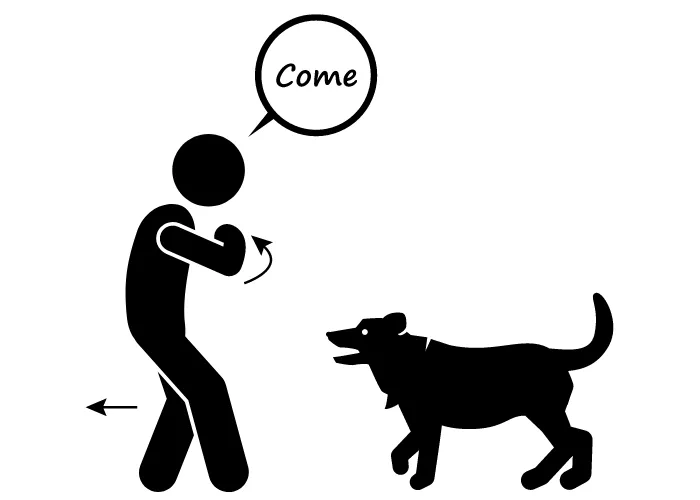
Being another multi-purposed command, “come” can also be used for the owner’s convenience, as well as for the safety of the dog. Using our previous example of a dangerous animal strolling toward your yard, a well-trained dog will heed your call to “come” rather than push its luck with the intruder.
In that regard, you can get the dog inside without having to leash it up to get it in the house. But overall, “come” is a command that is often used in ways that build relationships.
Depending on how it’s used, it cues the dog into your wanting to spend time with it either via a walk, playtime or to come because you’re dying to give the dog some praise and attention.
EXAMPLE:
Say you’re at the beach, and the surf is high and dangerously rough. Eventually, your dog wants to jump in for a dip, but you don’t want to risk it being swept out. This is where you’d be happy to know that the dog has learned the “come” command to cause it to turn back to you rather than treading water.
There are a few different methods of training your dog to come on command, but the easiest is through a long leash. Tell it to sit, and after it does, take a few steps away and tell it to “come.” This is just the opposite of teaching it to stay.
Give it a treat and praise if it stands up and steps to you. Repeat the process, walking further and further away from the dog while it is in its sitting position. This is a great opportunity to practice all three commands in one situation (sit, stay, come), breaking the stay command with the come command.
4. No (That’s about Enough of That!)

No matter what breed of puppy you intend on training, “no” is a command that you might get sick of hearing come out of your mouth because of how often you’ll need to say it. However, the less you find yourself using it is evidence of how effective your training has become.
Here’s something that will help you tremendously down the road…
Never let a puppy’s cuteness dictate your “no” command! Instead of seeing a cute little puppy chewing playfully on your socks, being caught up in how cute it is, envision that puppy as an adult chewing on your furniture.
That might be an extreme example, but you get the idea. Bad habits are tough to break, so nip them in the bud early before they form. Use “no” meaningfully, and the puppy will learn its boundaries.
EXAMPLE:
An example of when you’d use a “no” command with the dog is if it is starting to pull on its leash while you’re taking it for a walk toward something that you don’t want it to. A cat, squirrel, or another dog are a few such roadside distractions. Using “no” appropriately can teach it to “not even think about it” or to course correct.
The best tip for this command is to use a firm tone when telling it “No.” This tone of voice should only be reserved for a correctional command type (such as this one).
This isn’t the type of command that you can sit the dog down to teach. You must catch the dog in the act of unwanted behavior. Be careful not to overuse this command, making it just background noise to the dog over time.
Say it firmly and sharply while taking away what it might be trying to get, removing it from a place it’s not supposed to be, etc.
Between the tone, the command itself, and being corrected afterward, the dog will eventually learn to properly associate “no” with your wishes to stop whatever it’s doing.
5. Drop It (Put it Down!)
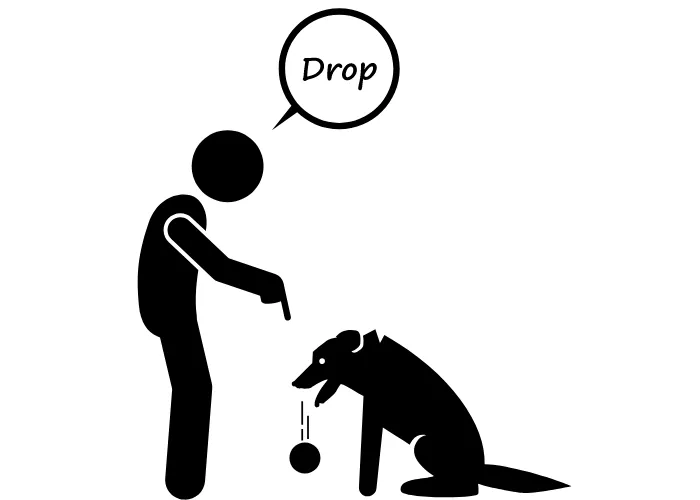
This must-know dog command can be used in play and carried over to tackle disciplinary needs.
In play, it could be to command the dog to drop its toy so you can grab it and chuck it across the yard for the dog to chase and retrieve. From a disciplinary sense, if you find your dog walking around with your hairbrush, you’d want it to “drop it” to prevent it from becoming a new chew toy.
EXAMPLE:
If you’re outside with the dog and it grabs the garden hose and starts to pull around with it as if it’s a rope toy, you’d quickly and sharply tell it to “drop it.” Or, if you’re playing with your dog and it doesn’t want to release the toy so you can pick it up and throw it, you’d instruct the dog to “drop it.”
You might notice in the examples above that there are two different scenarios. One would be correctional, and one is more playful. How you use your tone of voice would cause the dog to understand the difference between the two. Your tone will give the command a different meaning or level of severity.
The easiest way to teach your dog the “drop it” command is to give it a toy, and tell it to drop it while influencing the dog to release it to the floor. Immediately after it drops the toy, please give it a treat and a good deal of praise. Then, repeat this process until you must use less and less physical persuasion.
6. Heel ( Get by My side! )

“Heel” is a command that helps to make the dog more manageable during certain situations. It teaches your pup to get by your side as close as possible- right to your “heels.”
You may instruct it to heel at home so it’s right beside you rather than bursting out the door when your kids walk through the door after school.
Or, if you’re out for a walk and you happen across another dog owner with their dog on a leash that neither you nor your dog is familiar with, you might want the dog to “heel” rather than chance a dog fight.
EXAMPLE:
If you’re taking your dog for a walk and it’s all over the place, you’d want to tell it to “heel.” A dog trained in this command will fall into place by your side, and either matches your pace if you’re moving or stand patiently waiting for you to begin walking.
As this command is most often used when the dog is on a leash, it would be the easiest to begin training this command with it on its leash. When the dog starts pulling away or falling behind, tell it to “heel” while reeling in the dog by the leash into position by your side. Once it gets to your side, please give it a treat and praise. Repeat until it falls into place upon the “heel” command.
7. Down (Get Back on All Fours!)
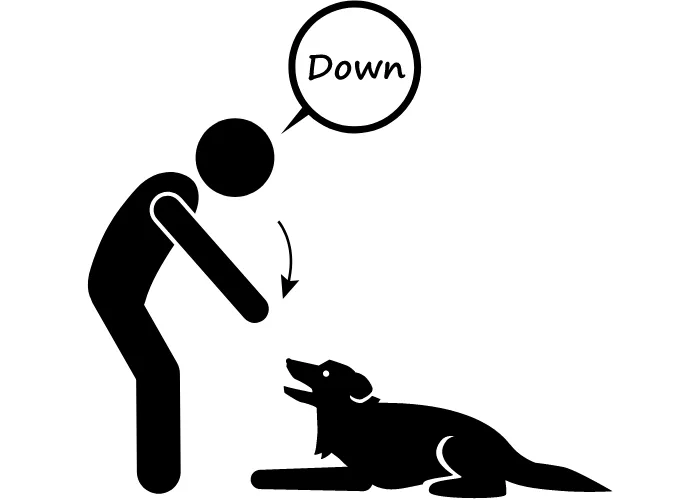
This is often used as a behavioral correction command but can also be used in play or while training for tricks. The benefits of the “down” command are self-explanatory.
If it’s on the good furniture, you’d tell it to “get down” or just “down.” Either one you choose, as aforementioned, stick to one word or phrase to help the dog understand what you’re trying to convey.
EXAMPLE:
This is another command that can be used in two ways. If your dog stands up on its rear feet to reach a plate of someone’s food on the table, you’d sharply tell it, “Down!”
If you’re winding down for the evening and the dog is behaving a little too rambunctious, you could softly tell it “Down,” instructing the dog to lie down and relax.
As is usually the case, this command is most easily taught using treats. Begin with the dog in the sitting position. While holding the treat in front of the dog’s nose, gradually lower the treat to the floor. Depending on the dog, you may pull it toward you while lowering it to provoke the dog into a laying position.
Once it does lay down, give it the treat and praise. Then, make it stand up somehow and repeat the process until the command causes more persuasion than the maneuvering of the treat.
8. Off ( You’re Not Supposed to Be There! )

This command isn’t as popular as the rest but should be implemented during appropriate occasions. This is particularly handy if you have a dog that likes to jump up on people.
Teaching it “off” instructs the dog to get off the visitor, your lap, the furniture, the hood of your car, etc.
EXAMPLE:
Your guests have arrived and are greeted at the door by your dog putting its paws on your guest’s shoulders while trying to lap their faces. But much to your guest’s relief, you have taught your dog the “off” command, which tells the dog to retreat to the floor.
Much like the “no” command, this behavioral correction command requires your dog to do things it’s not supposed to do to teach it. However, when you catch your dog on something that shouldn’t be on (the table, furniture, or your houseguests), sternly tell it “Off” while correcting the dog. Correcting the dog means manipulating it to either get off something or when pulling it off someone.
Try to create scenarios that would encourage the dog to do something that would give you a reason to teach the “off” command. If you’re the one who set it up, it’s more controlled, less intrusive to others, and a less sporadic training situation. When the dog finally gets off, please give it a treat and praise.
9. Quiet ( The Neighbors are Trying to Sleep! )
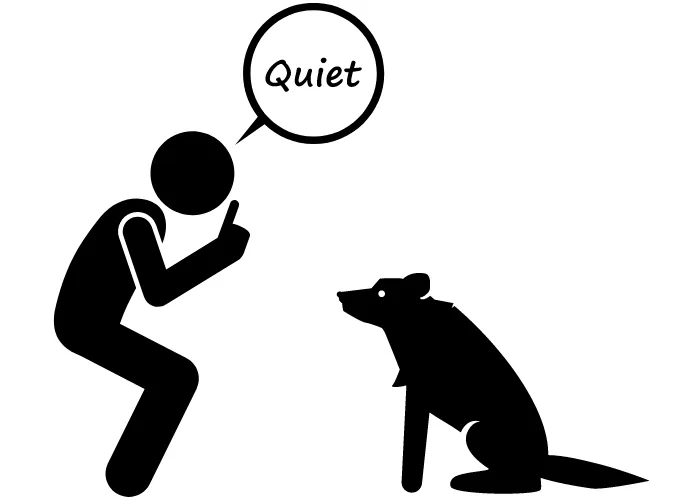
Some breeds are naturally quiet; others, well, not so much. Sometimes it’s wise to heed a dog’s bark, as they might be barking for a good reason.
But there are other times it’s barking for unnecessary reasons, but they need to be trained to know what’s necessary and what’s not. If you live in an apartment building, you understand how important it is for the dog to learn “quiet” as soon as possible.
EXAMPLE:
When it gets late, all goes quiet outside, and every little noise that goes unnoticed during the daytime draws attention to itself at night, especially in a dog’s ears. Because it’s a dog, it will start barking at the noise, unsure of what or who broke the silence. In this instance, your neighborhood with be thankful that you’ve taught your dog the “quiet” command, getting it to shut its trap and relax.
To teach your dog the “quiet” command, you need to find a common reason for it to bark to promote training or wait for it to do it on its own, and strike at the opportunity while the iron’s hot. While the dog is barking, grab its attention with a raised palm or other hand gesture and tell it “Quiet” in a stern yet even tone, so as not to excite the dog.
When it does stop barking after you tell it “Quiet,” give it a treat and some praise. If it starts back up, repeat the process. You may lose a little sleep, but it will be well worth it in the long run. Eventually, the dog will associate “quiet” with the absence of barking, and follow through with the command without the treat.
10. Go ( Release the Hounds! )
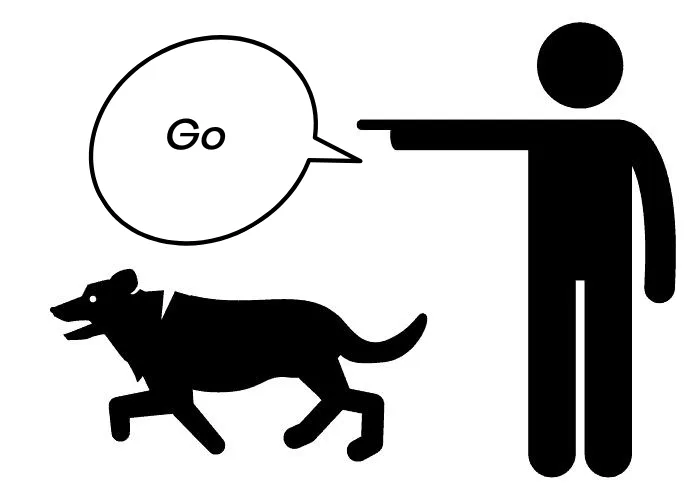
Sometimes the dog needs to be instructed to “go.” If you’re in the kitchen cooking and the dog won’t stop begging or trying to grab a bite if you make one false move, the dog needs to know what you’re talking about when you tell it to “go.” In this case, it’s typically to another room.
But it can also be used in other circumstances, like during playtime. For example, if you’re cycling through different commands while at play, you might tell the dog to sit, stay while you throw a ball, then tell it to “go,” letting it know it’s time to go after it.
EXAMPLE:
While playing with your dog, you may want to teach it to sit and stay as you throw a toy across the yard. You instruct it to “go,” causing it to take off in a burst of energy and excitement as it sprints to get and retrieve its toy.
To teach this command, it is best to pick a spot where your dog is comfortable to “go” to with little promotion. If a dog is crate-trained, you can use that or its favorite spot to land itself throughout the day.
Place a treat in the crate or its favorite spot and tell it to go while promoting it to move toward the treat. At times, holding the dog in the sitting position and pointing to the treat while telling it to “go” while guiding the dog in the right direction is the best approach.
Once it reaches its destination, please praise it, and repeat the process in different locations at greater distances.
Basic Dog Training Command Tips
The following tips will help you ease into training your dog as effectively as possible. These tips are effective for most, if not all, of the ten commands listed above and can be helpful with other commands that you might find handy as your dog matures.
Introducing New Commands to your Dog
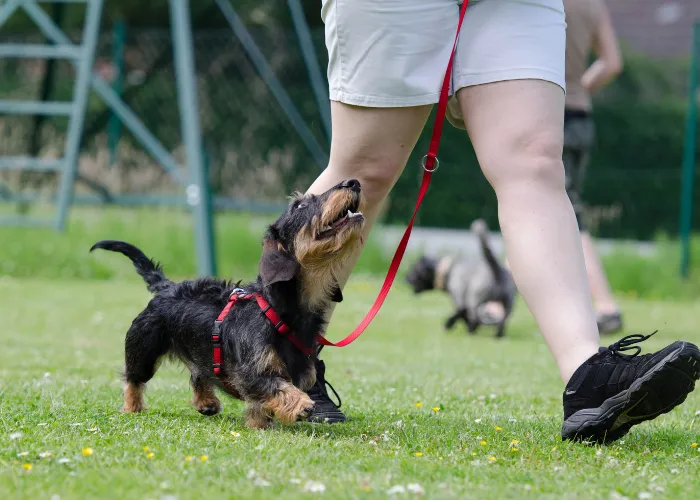
Let’s face it; puppies can only understand so much. So, it’s best to work with what they can already do by nature: to “sit.” Teaching your dog to sit can be the easiest because they can already do it.
Gently pushing down its rump while pushing on its chest to get it into the sitting position while saying the word “sit” will eventually create a connection between the action and the word. Paying the puppy off with a treat after a successful sit will get its wheels turning about how to earn another treat.
Repeat the process, but only reward the pup when it sits and remains there for a reasonable amount of time (a few seconds of sitting). Keep up with it periodically throughout the day, and remain consistent.
After a few days, you might be able to tell it to sit and have it do it all by itself, even sooner, depending on the breed. Allow it to master one command before moving on to a second. This process can be used for nearly every command in the list above, leaving the trickier ones for when they’re more appropriate as the dog progresses.
Using Vocal Cues

Above, several commands can be used for different things- some in more friendly circumstances and some in a disciplinary manner. The tone of your voice can assist you in getting the dog on the same page as you use these commands.
Not the volume, unless you’re trying to excite the dog, but the tone of your voice will clue in your intentions behind a command. You can say the same command playfully and sternly and get two different responses- so long as you’re consistent.
“Go” is a good example of what I’m talking about. If you say it playfully or energetically, the dog will tear after what you’re telling it to go for happily and full of gusto. But if you say it with a deeper, firm, or measured tone, it might just drop its head and walk away. The tone of voice is an important training tool your pup will learn to pick up on.
Using Physical Cues
With some basic dog commands, it is a good idea to use hand gestures simultaneously with the command. It is popular to point down toward the dog’s rump while telling it to sit. Eventually, the motion of pointing will cue the dog to sit without having to tell it to do so.
Positive Reinforcement

Face it, anything alive would rather do what they want than do what they must do. Positive reinforcement promotes your dog’s desire to do what you’re instructing rather than having to do it.
Giving your dog a treat, praise, and things of the like, are all facets of positive reinforcement when the dog achieves what you want it to do. This makes the dog want to do it again, hoping to be rewarded when it does well.
Create Patterns With your Dog and Be Consistent
You’ve read it a few times, but it bears repeating- use the same words for desired commands every time. Don’t switch it up because it is likely to confuse the dog.
Repetition is key in teaching the dog to get on board with what you’re trying to tell it. Alongside repetition is patience. Patience with your dog will play a large hand throughout training and eventually reap dividends.
Advanced Dog Training Commands After the Basics
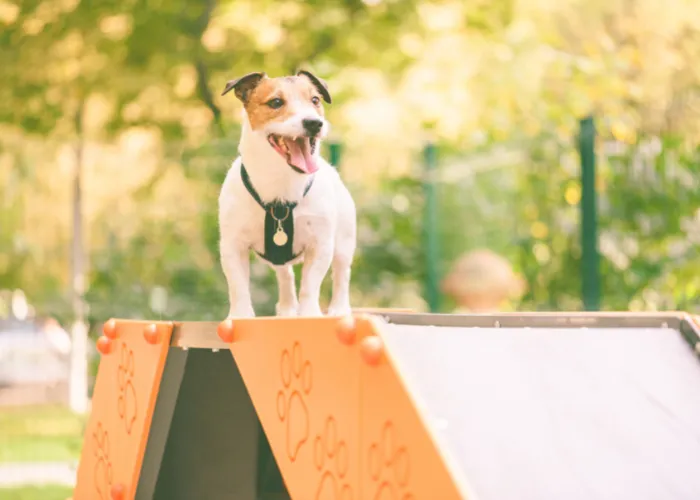
In time, your pup will master each command if you’re patient, repetitious, justly rewarding the dog when it fulfills a command, and consistent with the training. When it has the basics down to a science, it’s time to step it up.
Dog Training- Commands from a Distance
Teaching your dog to obey commands from a distance will help you to communicate with your dog when out in the woods, across the yard, or in the dog park. The best way to achieve this is to start small and over time grow the distance between you and the dog.
For the record, it’s a great time to teach it to stay while you walk away to get some distance for the next command.
Training your Dog Through Distractions
Training your dog is one thing, but you’re not only training to pay attention during training sessions. You’re training your dog for daily life interactions. Daily life isn’t always so structured, quiet, or orderly.
Training your dog when there are many distractions is a great idea to ensure that it will still be able to respond appropriately through attention-grabbing scenarios. You could start to train the dog with a TV on, kids playing, taking the dog into a busy (yet safe or dog-friendly) area of town, or whatever else is at your disposal.
Teaching the Dog Command Combinations
When your dog has become a pro at the basics, you can teach it more advanced behavior by combining them. Sit then stay is one, down then heel is another, and so on.
This might take some practice, but they’re still dealing with what they know at the roots. If anything, they learn to respond to individual commands quicker while learning combinations.
How to Avoid Common Mistakes Dog Owners Make During Training
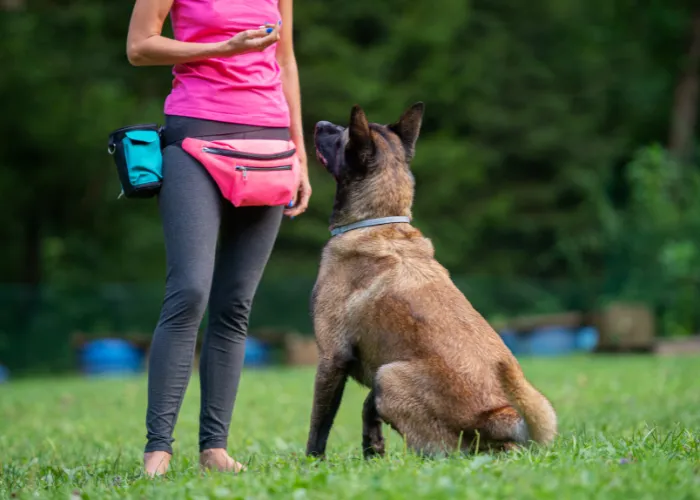
1. Lack of Consistency
There are three major areas where consistency is key to successfully training a dog. For many owners, inconsistency with the following three can be at the root of their frustrations throughout the dog’s training years.
Consistency with Words
Mixing your verbiage for a single command will confuse the dog’s mind. Using the same word or phrase every time you command the dog is important to keep the dog on the same page.
Consistency in Tone
There’s a tone to use when the dog’s in trouble, one to use when it’s time to calm down, and one to use during playtime. Mixing these up may direct your dog to think differently about the command than you intend.
Consistency in Frequency
Stay on top of every situation that you can. Don’t let convenience dictate the rate by which you train your dog. In other words, if the dog is doing something that it shouldn’t, being comfortable and not feeling like getting up will not gain any ground in the dog’s training. It may even start to think that it’s okay to do what it’s not supposed to when you’re relaxing, so remain patiently consistent.
2. Neglecting Positive Reinforcement
Positive reinforcement makes the difference between wanting to please versus having to please. When the dog wants to please its owner, training is that much easier. Without using positive reinforcement such as rewards through treats, praise, and an affirmative means of acknowledging the dog’s achievement, things become a chore to the dog rather than developing positive habits.
Shouting, hitting, and inappropriately scolding the dog will only build up timid and possibly aggressive behavior. And tragically, it will create a fissure in the trust that should remain between the dog and its owner.
3. Training in a Busy or Distracting Environment
Holding the attention of a distracted dog steeped in distractions can be an extremely frustrating experience for the owner. When training the dog to a command from scratch, find a quiet and peaceful setting so that you remain the dog’s focus.
However, once the dog gets its commands down from front to back, then introduce some distractions to practice obeying commands in busy situations. But doing it from the start will often end in the owner spending all their time gaining the dog’s attention rather than training.
4. Giving Up on Training
Without being patient and persistent, owners wind up giving up on training their dogs- at least with certain commands. Any dog can learn basic, reasonable, and important commands with enough persistence and patience.
One important thing that hasn’t been said in the tips above is that it might take quite a while for your dog to learn certain commands. Don’t give up just because the dog doesn’t seem to get it. It will; just be patient and keep driving the point home as often as you can. Sometimes it takes a while before the dog has a eureka moment.
5. Being Stingy or Going Crazy with Dog Treats
As you surely noticed, every command training technique revolves around treats. But there is such a thing as too much or too little. Also, just because the package says that it’s a treat doesn’t mean that it’s something that the dog would do anything for.
A treat that works the best is one that the dog enjoys the most. But it is important to ensure you don’t over-reward your dog with treats after each accomplishment. If you do, you’ll find that interest will wane in the training session as its belly gets full.
On the other hand, if you’re stingy with the treats, the dog will begin to get anxious about wanting the treat and lose patience. Your dog knows the treat isn’t coming, so it may start doing its own thing.
A small treat with praise after it fulfills a command (whether it is because you manipulated it to comply or it did it on its own) will keep the dog anticipating further treats as a reward and also won’t stuff the dog full of treats.
6. Forgetting to Reduce the Amount of Treats
You’re not just teaching the dog tricks but how to behave and respond to daily life-type commands. You’re not going to want to be giving it treats every time it does what you say, right?
Treats should be gradually reduced over time as the dog learns the actions that coincide with each command. Maybe increase praise to compensate for a while. Cutting off the treats cold turkey will yield a mix of responses, most of which won’t build better training sessions. A gradual reduction as the dog improves will always be the best approach.
7. Not Creating a Strong Focus
Sometimes owners tend to part themselves from their dogs when training. Kneeling, sitting, or bringing yourself closer to their eye level will create a more focused, intimate training atmosphere for many commands.
8. Beating a Dead Horse
Consistency doesn’t have to mean the same training routine daily. Try to mix things up to keep it fun and interesting for the dog. Keep the training process for each command consistent, but try to be creative circumstantially.
9. Not Showing Enough Praise
The rewards of accomplishing a command are a two-part system- treats and praise. Sometimes an owner might forego the praise and move to the next command. Make sure to include plenty of praise for every job well done throughout the stages of training the dog a command.
10. Not Being Reasonable
What an owner finds a reasonable pace for a dog to learn essential commands might be completely different from reality. This is avoided when you start and stay simple until the dog has mastered them. Then move along to more difficult or tricky commands. Be reasonable with what your dog is capable of and the rate of speed by which they learn.
11. Not Picking Up on Body Language
Sometimes, the owner has a tough time training their dog because they aren’t familiar with its body language. Is the dog stressed out, anxious, uninterested, hungry, thirsty, exhausted, having to go potty, or frightened? Any of these will cause training to become a dragged-out chore that will be far less effective than when the dog is ready to be taught.
Much training is a mental game, and their head needs to be in the right place to learn. Picking up on physical cues will give insight into what’s happening in their head. Remedy what you can, and see if it’s in a better mental space to learn. If so, it will be a much more meaningful session.
The Mutually Beneficial Rewards of Training your Dog
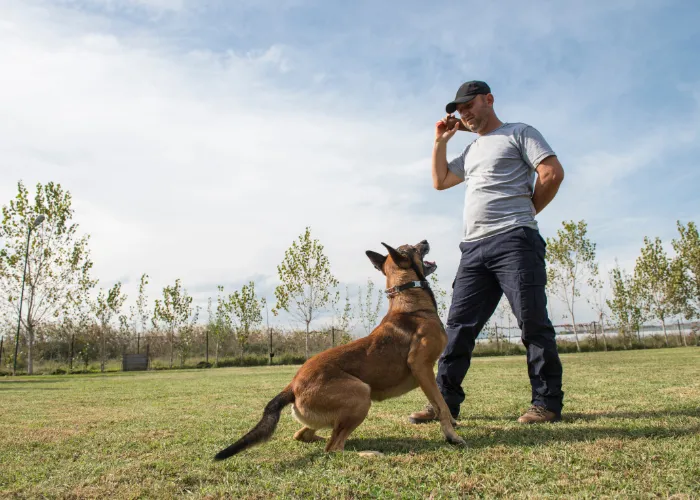
1. Obedience– An obedient dog is a reward unto itself. This is true because the owner appreciates its obedience, and the dog lives a happier life, not getting into trouble or danger all the time.
2. Effective Communication– There is something special about the bond between a dog and its owner when it knows what the owner is talking about.
3. A Safer Dog Life– Many of the commands above can be used to keep the dog out of harm’s way. Keeping a dog well-trained can spare an owner the heartbreak of tragedy.
4. Balance at Home– Being in control of your dog’s behavior through commands and further behavioral training makes the experience far more pleasurable and keeps a healthy balance within the home.
5. Quality Time– Training doesn’t have to stop at the basics. Training tricks or other tasks energize the dog, and quality time is spent between the dog and its owner.
6. Energy Management– Most dogs require much exercise to burn off some pent-up energy. Blending playtime with training is a great way to kill two birds with one stone. Granted, training will become easier after some energy is blown through.
7. Introduce Socialization– Socialization as early as possible is a great way to train your dog in proper behavior between other humans and other dogs. This can become incorporated into its training after it has completed some of the basics.
8. A Confident Dog– A well-trained dog is a confident dog. It knows what you want, what’s expected, and how to behave. Less worry, stress, and trouble make for a happier self-confident dog.
9. Solving Puzzles– Problem-solving is a mental stimulant for many breeds, and this can be energized through solving the problems put before it while in training.
10. A Better Quality of Life– Better training means less trouble, more praise and good times for the dog, and a happier overall existence for everyone involved.
11. There is Fun to be Had– Training doesn’t have to be a chore for either the owner or the dog. It can be a fun and rewarding experience training your dog.
12. A More Adaptable Dog– A well-trained dog can adapt more to different environments or situations. Knowing commands and being confident that its owner has not led it astray in different circumstances contributes to this.
13. Training Creates Efficiency– The more you successfully train your dog commands, the more commands you can train as time passes. The variety of commands can become more particular, creating a more efficient system between a dog and its owners.
14. Faster Learning– After a while, the dog understands when you want it to learn something. This helps it pay attention to what’s happening, making it quicker to teach a new command.
15. Better Equipped to Deal With Emergencies– When an emergency happens, a well-trained dog can make dealing with the situation much easier by getting out of a burning building and sticking with its owner, for an extreme example.
Final Thoughts

Training your dog correctly and efficiently is paramount when safety, quality of life, and a more fluent relationship are concerns for both the dog and the owner. Most breeds can handle the challenge of being trained well from puppyhood, and all handle being trained with different degrees of difficulty.
Be honest with yourself, though.
Do you have the time and availability to train the dog properly?
Remember, consistency is vital to the success of the training. If you don’t have time to spare for training the dog daily throughout its early months, perhaps it might be time to hire a trainer to ensure it has the best shot.
In the end, there’s nothing like having a well-trained dog.
The peace of mind that comes with a dog you don’t have to worry about behaviorally can’t be understated.
And every effort you make today with your dog will foster a great relationship that will continue for years to come.
REFERENCES:
- “Teach Your Puppy These 5 Basic Cues.” American Kennel Club, https://www.akc.org/expert-advice/training/teach-your-puppy-these-5-basic-commands/
- “21 ESSENTIAL DOG COMMANDS TO TEACH YOUR DOG.” Gallant, https://www.gallant.com/blog/dog-commands/.
- “5 Essential Dog Commands.” Cesar’s Way, https://www.cesarsway.com/5-essential-commands-you-can-teach-your-dog/.

